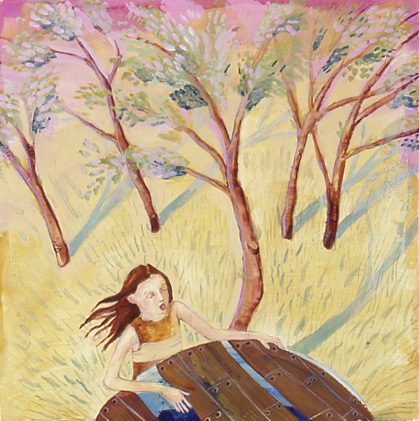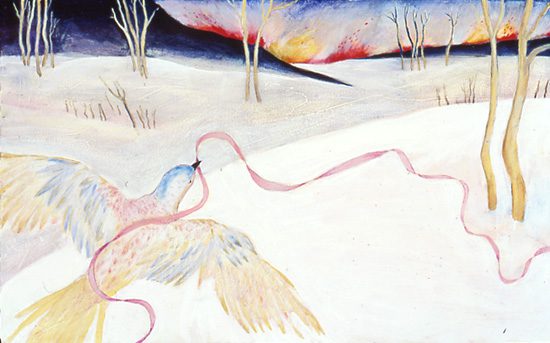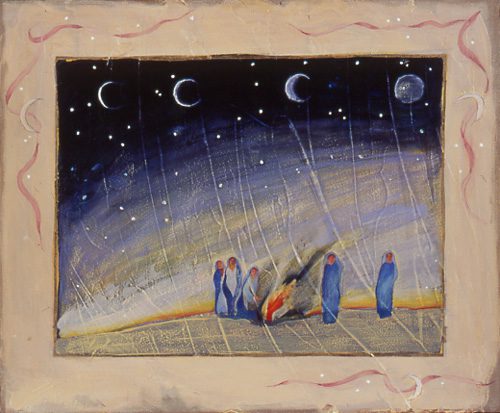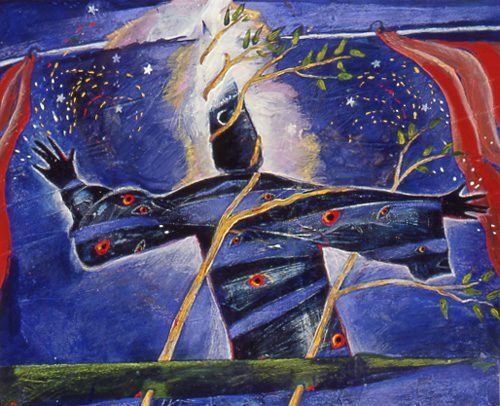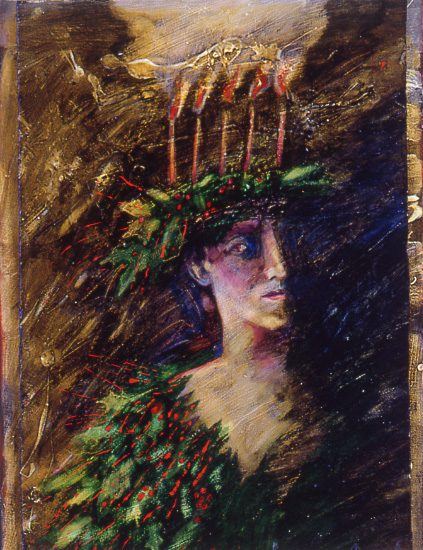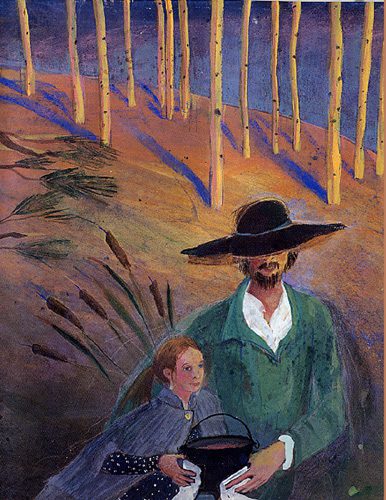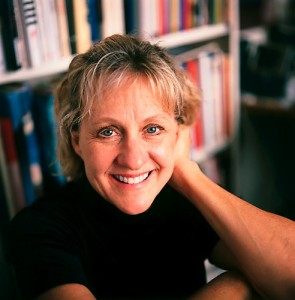
By E. Liza Richards, ’02
VISUAL ARTS
A BYU illustration professor deepens children’s stories through art.
In the office of Bethanne Parker Andersen, ’76, books of all shapes and sizes sit on row upon row of shelves. A worn copy of Where the Wild Things Are leans wearily on a stoic-looking collection of Rembrandt prints, while an anthology of Fra Angelico’s Renaissance art is pressed tightly between Alice in Wonderland and The Wizard of Oz. Interspersed throughout these books are a few with Andersen’s own name printed on the glossy spines.
Andersen, an assistant professor of visual arts, an illustrator of six books, and a recent recipient of a BYU Young Scholar Award, began her artistic endeavors at age five. Using her father’s art pencils, print paper, and her youthful imagination, she wrote and illustrated stacks of makeshift “books.” Her eventual plan, however, was to be a painter, not an illustrator. “I was going to be Rembrandt,” she recalls. At BYU Andersen studied abstract painting for both her bachelor’s and master’s degrees. It wasn’t until 10 years later, with artwork displayed in museums and private collections across the country, that this “half mom, half artist”—as her son described her—first considered illustrating. “I used to love to look at picture books with my boys,” she says. “I actually had Where the Wild Things Are memorized.”
Shifting her career, Andersen went to New York to study illustration at the School of Visual Arts. One of her first books, Seven Brave Women, told the story of generations of courageous but peaceful women who lived during wars but made a difference without fighting in them. An immediate and overwhelming success, Seven Brave Women garnered the Jane Addams Children’s Book Award in 1998, given to the book that most effectively promotes world peace, and a Boston Globe–Horn Book honor. “The Boston Globe award is one of our ‘big three’ in the publishing world,” says Betsy Hearne, author of Seven Brave Women and literature professor at the University of Illinois at Urbana-Champaign.
Andersen’s training in abstract, conceptual art spills over into her illustrations. For example, in Seven Brave Women she uses symbols to deepen the meaning of the text. On the first page a downy dove holds a pink satin ribbon in its beak; the ribbon curls across the following pages, touching each woman before slipping onto the next page. “The dove is the bird of peace,” Andersen explains. “And this peace dove holds the ribbon that ties together the generations of women. At the end, the ribbon is passed to the young girl narrating the story as if to say, ‘Here is your heritage; now what will you become?'”
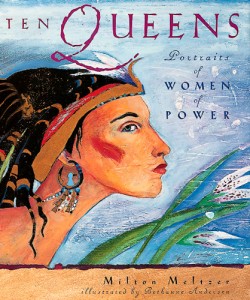
“In children’s books,” Andersen explains, “the art extends the text. You don’t just illustrate what the text says, you add something the author hasn’t put there.” Take, for example, the story of Nellie, who “rode her horse on a real saddle” (p. 7). From that scant text Andersen created an image of a young girl mounted on a magnificent yellow horse that leaps across a two-page spread. “Bethanne emphasizes the action in the words. The focus is on what the characters are doing,” says Hearne.
In Andersen’s illustrations even the backgrounds add motion. By spreading a layer of gesso, a thick art paste, across the canvas with her palette knife and then variously applying brilliant shades of oils, watercolors, or pastels, Andersen creates textures that lend a fluid, whimsical quality to her paintings. The broad strokes of gesso give the sensation of a breeze swishing through the pages of her books, lifting soft ringlets from a woman’s face, and tangling loose apron strings. In Andersen’s portrait of Cleopatra from the book Ten Queens, this breeze bends stalks of lilies away from Cleopatra’s face, adding to the regal, defiant attitude of the queen.
Andersen also adds to the text by ensuring that her illustrations are historically accurate. “Believe it or not,” she says, “I spend about two months researching for historical illustrations.” For Kindle Me a Riddle, a pioneer story, Andersen went to the pioneer village at This Is the Place Heritage Park in Salt Lake City and took pictures of cabins, pots, brooms, and fireplaces. “I researched every little thing. You wouldn’t guess it, but the children’s leather shoes and the paisleys on the shawl are all authentic.”
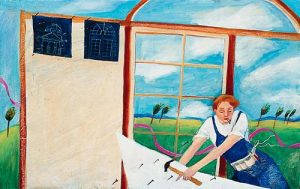
Andersen’s knowledge of art history has also influenced her illustrations. When illustrating Seven Brave Women, she says, “I wanted to portray these women as they would want to be remembered. I wanted to paint them in a very simple, very direct, very spiritual way.” So Andersen studied the faces of the angels and icons of Fra Angelico, an early Renaissance painter, and transposed his calm, pious expressions onto the faces of her characters. “These women lived incredible but simple lives. They deserve to be Angelico-like,” she says.
Andersen says she looks for inspiration anywhere she can find it. “In one seminar class,” says Andersen’s former student Anne Marie Infanger, ’01, “she invited speakers from different disciplines—English, music, biology—to speak about what they did and the role of creativity in their work.” Similarly, Andersen looks to many artists’ works for inspiration. “I look at their work,” she says, “and it inspires me to go and paint better. I can’t paint as gorgeously as they do, but I draw inspiration from their genius.”
Her own genius, however, cannot be easily ignored, says Hearne. “Bethanne has the ability to see beauty in the ordinary. She shows that plain people and plain situations can have beautiful aspects.” Virginia Duncan, an editor at Greenwillow Books, which published three of Andersen’s six books, agrees. “She has a unique way of looking at the world. It makes her a very thoughtful illustrator.”
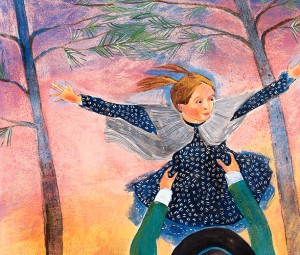
Andersen uses various shades from her rich, vibrant palette to shape the mood of each painting. In Ten Queens, Boudicca, a fearsome queen who led her Celtic tribe in a violent revolt against the Romans, glares at the reader, her flaming red hair echoing the hues of the smoldering fires in the blackened background. In contrast, a picture from Kindle Me a Riddle evokes a calm, quiet mood as a pioneer girl walks with her father through a forest full of bright cobalt shadows falling from pale yellow birches touched by the light of dawn. “When people look at my work,” says Andersen. “I want it to have an emotional impact—I want the work to feel deeply.”
With open books in her arms and on her lap and desk, Andersen says, “I think Alice in Lewis Carroll’s Alice in Wonderland said it best: ‘What is the use of a book without pictures?'” Leaning back and looking at her shelves of books, she says, “It’s true. You may have beautiful art, and you may have wonderful text, but when you combine the two, the illustration and the story, that is where the magic occurs.”
See more art below:







